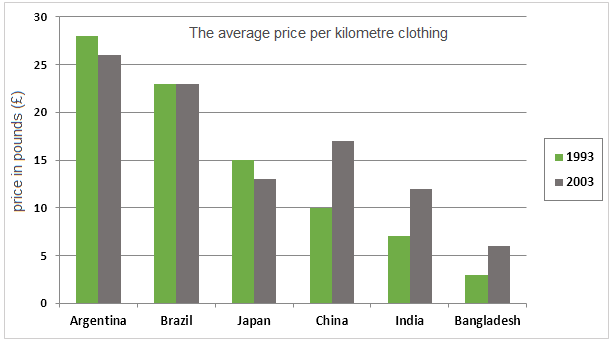» You should spend about 20 minutes on this task.
The average prices per kilometre of clothing imported into the European Union from six different countries in 1993 and 2003 are shown in the bar chart below. Summarize the information by selecting and reporting the main features, and make comparisons where relevant.
You should write at least 150 words.

Sample Answer 1
The column graph compares the import prices of per kilometre clothing by the European Union from six different countries in 1993 with that of 2003. Overall, the EU paid the highest amount to Argentina for garments import and lowest to Bangladesh in both years.
As is seen, the European Union paid around 28 pounds for per kilometre clothes from Argentina in 1993 and this rate was highest. After ten years, it reduced to just over 25 pounds but still, Argentina received the premier price for clothing export to the EU. The second most value paid by the EU for cloth importing from Brazil and both in 1993 and 2003 they were paid roughly 23 pounds for the one-kilometre dress. Japan received exactly 15 pounds for that in 1993 but this rate dropped to roughly 13 pounds after 10 years. China was paid 10 pounds for each kilo costume the EU exported in 1993 and the price hiked to about 17 pounds in just ten years. The EU purchased Indian garments items for approximately 7 pounds a kilo in 1993 and the price doubled in a decade. The least amount for per kilo clothing was paid to Bangladesh by the EU in both of the years but the price went high in 2003 and was 6 pounds compared to half of that in a decade earlier.
Sample Answer 2
The bar graph shows average price the European Union (EU) spent for per kilometre clothing import from six different years in 1993 and 2003. It is obvious that the EU paid the highest amount for each kilometre costume to Argentina.
According to the illustration, the EU spent the highest amount for clothing import from Argentina which was approximately 28 pounds per kilometre in 1993. This rate was significantly higher; almost 9 times higher than the rate it gave to Bangladesh. The second and third highest rates were given to Brazil and Japan, roughly 23 and 15 pounds respectively. China and India got less than that and their rate was higher than the import rate from Bangladesh. The latter received only around 3 pound per kilo which was almost three times less than the rate paid to Japan.
The rate went higher in 2003 for China, India and Bangladesh who were the least paid countries in a decade earlier. The price for costume import from Brazil remained unchanged while slightly declined for Argentina and Japan. Despite the price changes, Argentina and Brazil were still highly paid than that of India and Bangladesh while China’s price went as high as 17 pounds, almost double than that of 1993’s rate.
